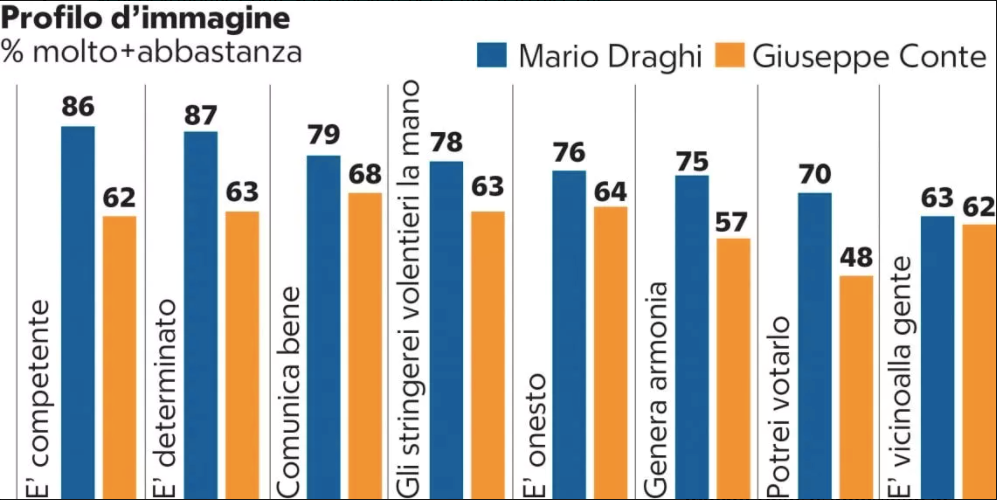
Monday Feb 15 2021 10:55

5 min
Italian politics has been nothing short of a soap opera. Take the formation of a new government in the middle of a pandemic, for just one example. Mario Draghi’s appointment following Conte’s confidence vote success was an unexpected plot twist in the already unpredictable storyline.
Now, of course, we’re all going to try and predict what happens next in the world of Italian politics. It’s a bit like betting on which Game of Thrones character is going to die next: someone will die, but try to guess who and how, and you’ll probably be wrong.
Still, Mr Draghi’s precedent as ECB President offers some signals as to what might be coming Italy’s way. He has cultivated a well-respected public persona, having been credited for saving the euro following the 2011-12 sovereign debt crisis. La Repubblica (an Italian newspaper) found Draghi beat former prime minister Giuseppe Conte in all categories (see chart below) and 85% were “very or fairly” pleased with his appointment.[1]

Source: La Repubblica (12 Feburary 2021)
His support doesn’t stop with the public; Italia Viva, Matteo Renzi’s party, firmly pledged its support early on in the process. The Democratic Party too agreed to work with Draghi (although, having strongly aligned with Conte, it may have been more of a truce). Nicola Zingaretti, its secretary, stated that “the united Democratic Party is on the field and ready to support this new challenge”[2]. Even Matteo Salvini, leader of the League, has pledged his support and willingness to “put aside ideology, prejudice, and arguments and get to work.”[3]
The only party to take an anti-Draghi stance is Fratelli d’Italia. They likely spot an opportunity to take the mantle of the only anti-establishment party now that the League and the 5 Star Movement have backed Super Mario. The cracks are already starting to appear for those parties, with the 5 Star Movement having a bit of an existential crisis at the moment (aren’t we all?). Their conundrum comes from the dilemma of backing Draghi – the establishment incarnate – or backing a crisis. 59.3% of party members might have voted to support the new executive, but a hefty 40.7% voted no.[4] Internally, the party is fractious.
Salvini is more willing to play along because he has his ulterior motives: a say in the Recovery Fund, and influence over the probability of an election. The League is at the top of the polls, and an election in the near future would be politically advantageous for Salvini. Draghi’s is the 7th government in a decade and survival for another two years with no election will be difficult.
In uniting opposing parties such as the League and the Democratic Party, Draghi has spread his unity government so broadly across the political spectrum that even his Super Mario reputation might not save him. How to navigate the reforms – ranging from the long-awaited judicial reforms to make civil trials shorter to a green economy transition[5] – that Brussels are expecting with such an eclectic array of ideologies, some of which directly clash? The new prime minister’s policies will be directed through an extremely narrow tunnel of what these parties are able to agree on.
And time is offering little mercy. Unemployment rose in December, reaching 9%. Among young people aged 15 to 24, it reached 29.7%.[6] In 2020, the number of Italians needing help to buy food rose by more than one million according to the farmers’ association Coldiretti. Tackling this is going to take not just vast fiscal stimulus, but also a level of political stability that Italy hasn’t seen in years – and in the midst of a pandemic. Draghi might support a “very strict regulation (of the markets) and a welfare state that offers protection to those caught out” [7], but the “whatever it takes” philosophy can only make a comeback with the support of parliament. Italian politics is infamous for its fickle nature, and it is inevitable that allegiances will change. Draghi’s challenge is to minimize this.
Many are optimistic of his role in both Italy and the EU. There is good reason for that; his ministerial appointments have focused on expertise and competence. The finance minister is in the safe hands of the deputy governor of the Bank of Italy, while the former head of the constitutional court, Marta Cartabia, has been given the position of justice minister.
But the huge amount of political instability that Draghi faces must not be understated. This is Italy and the drama is far from over.
[1] https://www.repubblica.it/politica/2021/02/12/news/draghi-renzi-sondaggio-piepoli-287178947/
[2] https://www.agi.it/vista-tv/video/2021-02-12/governo-draghi-zingaretti-pd-unito-pronto-sostenere-sfida-11378394/
[3] https://www.7colli.it/salvini-spiega-il-si-a-draghi-ci-sono-da-spendere-200-miliardi-voglio-esserci-video-30759/
[4] https://www.repubblica.it/politica/2021/02/12/news/governo-draghi-quirinale-_ministri-287181374/
[5] https://time.com/5938818/italy-mario-draghi-leading/
[6] https://www.istat.it/en/archivio/253024
[7] https://www.france24.com/en/live-news/20210209-how-long-with-italy-s-honeymoon-with-draghi-last
